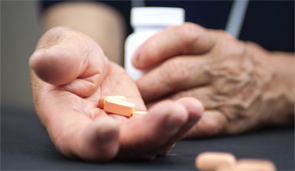
Determining the efficacy of treatment in Axial SpA requires patience.
Image Credit: Hriana/shutterstock.com
ROME, Italy—When it comes to thinking about disease modification—a main goal in the treatment of axial spondyloarthritis (axial SpA) and other inflammatory diseases—it’s time to reconsider the concept, an expert said at EULAR 2015, the annual congress of the European League Against Rheumatism (EULAR).
The traditional way of assessing disease modification, inhibiting radiographic progression, is essentially out of date because it is kept in check so well by today’s treatments, said Robert Landewé, MD, professor of rheumatology at the University of Amsterdam.
“We don’t see a lot of radiographic progression anymore,” Dr. Landewé said. For that reason, these changes might have fallen out of line with true outcomes and what really is important to patients.
Maintain Structural Integrity
He proposed a paradigm shift—to start thinking of disease modification as maintaining structural integrity.1
“That is what, in patients with rheumatoid arthritis, really matters,” he said. It’s what matters to patients with axial SpA, too, he proposed, except that the concern with structural damage in axial SpA is prevention of bone formation rather than bone erosion.
The use of structural progression to assess disease modification was borne out in a 2014 study of ankylosing spondylitis patients that found that those with the highest disease activity (ASDAS) scores were also the ones that saw the greatest rise in structural progression on modified Stoke Ankylosing Spondylitis Spine Score (mSASSS).2
Dr. Landewé cautioned, though, that there are some potential problems if this approach is used. Negative results have been seen multiple times in studies using anti-TNF treatment done over two-year periods—although there is some question about whether there is really no inhibition of structural progression or whether the results reflect a methodological problem with the studies, Dr. Landewé said.
Also, syndesmophyte formation early in axial SpA is fairly rare, making it difficult to address in the context of clinical trials. There is also the question of whether assessing syndesmophyte formation is actually enough, Dr. Landewé said. “Or is it only a component, and we want to know far more?” he wondered.
Dr. Landewé suggested that a “modern concept” of disease modification in axial SpA should involve an integrated approach of long-term suppression of disease activity; preserving structure; preventing disease-related co-morbidities; and preserving physical function and general health.
Treatment Results
The understanding of the nuances of treatment of axial SpA is broadening, said Joachim Sieper, MD, PhD, head of rheumatology at Charité University Hospital in Berlin.
